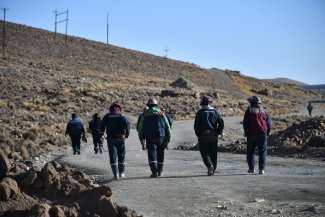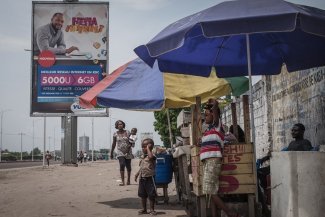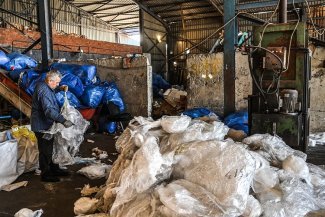At the end of September, the United Nations officially adopted the Sustainable Development Goals (SDGs) as a guide for international efforts against poverty for the next 15 years. The SDGs include a target for the elimination of slavery, forced and child labour.
Anti-Slavery International has been calling since 2007 for slavery to be recognised as a fundamental issue of poverty and development so the recognition of this in the SDGs is a crucial step.
But this is where it gets difficult.
Because for the target to be achieved will require a thorough reform of the ways in which we, as citizens of this planet, uphold labour rights, do business, manage migration, implement development, conduct diplomacy and advance the rule of law.
Each of these matters are profoundly political and fraught with contention by vested interests which are quite happy with the way the world currently is. Many new entrants to the struggle against slavery are content to see this struggle as merely a matter of locking up evil people by decent police.
They are unconcerned with the altogether more contentious questions that underpin the reality of contemporary slavery, such as state-acquiescence in caste- or ethnicity-based discrimination, denial of freedom of association and union rights to workers, undermining of rule of national and international law, refusal to establish safe migration routes for vulnerable workers seeking decent work, and the decriminalised international trade in slavery-produced goods and services.
But this is not good enough, and here’s why: 5.5 million. This is the number which indicts the Millennium Development Goals (MDGs), the previous set of anti-poverty priorities set by the United Nations.
Five and a half million is the International Labour Organization’s (ILO) most recent estimate, made in 2012, of the number of children in slavery. It is the same as the ILO’s estimate of the number of children in slavery in 2005.
In other words, in spite of all the real progress on poverty reduction and development, including a huge fall in the overall numbers of child labourers, during this period, international development has completely passed by the millions of children and, for that matter, the tens of millions more adults in slavery across the world.
There was not a single mention of slavery in the MDGs. Hence it has not been high on the agendas of aid decision makers over the past 15 years.
At best there has been a presumption that economic development will ultimately make slavery practices obsolete. This presumption misunderstands the nature of poverty which is not merely about a lack of things, but more fundamentally about a lack of power.
Systematic exclusion
Prejudice and discrimination against certain groups on arbitrary bases such as caste, ethnicity, gender and religion is still frequently used as a basis upon which the more powerful exclude the more vulnerable from the processes of development. By doing so those same mechanisms of social exclusion also render those discriminated against more vulnerable to slavery.
Those who are enslaved are drawn from communities which are systematically excluded from power to enable their control by those who are more privileged. They include Dalits and Adivasi in South Asia, migrants in Europe, the Middle East, the Americas and South East Asia, and people designated of a slave caste in West Africa.
Development and humanitarian practitioners have barely even been aware of these dynamics and so have failed to address them. If those who call themselves anti-slavery activists also ignore the fundamentally political nature of these challenges then we too will fail in the imperatives placed upon us by our mandates.
For example, if the international community is serious in its efforts against slavery how can we continue to acquiesce in the ready access to international markets and warm inclusion to the international polity of countries such as Uzbekistan, Saudi Arabia and Qatar, to name but three states, which, with differing degrees of cynicism, have effectively legalised slavery in within their borders.
Another example: It is unlikely that the UK has for a moment considered the potential impact that its naked disdain for the European Court of Human Rights will have on the rule of international law in general and as it relates to slavery in particular: that court has been vital since 2000 in forcing governments across Europe, including the UK, to properly respect the rights of victims of slavery. Any credible international struggle against slavery must therefore confront the British government on this, one of their most cherished political prejudices.
Similarly the decision of the UK Department for International Development (DFID) to pull out of India, citing the levels of its economic development, must be challenged on its most basic political assumptions. India is indeed an economic miracle for about 600 million of its people.
For 300 million Indians however the promise of economic and social justice will remain an unattainable dream because the powerful of the society have decided they should be excluded because of caste, religion or ethnicity.
Instead they are relegated to subsistence and enslavement in manual scavenging, brick kilns, sweatshops, spinning mills and agriculture. In pulling out of India DFID has abandoned the struggle of millions of the poorest for decent work and respect.
And, another political issue: should India be made a permanent member of the UN Security Council while its toleration of caste-based violence is so high, and its efforts to end slavery are so paltry?
First steps
The inclusion of slavery eradication in the Sustainable Development Goals is a recognition by the international community that it has until now comprehensively ignored some of the people in greatest poverty across the globe. But for this recognition to have practical meaning, it must be translated from a sentence in a United Nations pronouncement to a strategy that puts power into the hands of the excluded.
A first step towards this goal would be recognition that tackling slavery is not solely the preserve of law enforcement professionals. Frequently, such as in the brick kilns and quarries of South Asia, it is openly practiced. Therefore there should be a requirement of every credible development and humanitarian agency to consider if they could contribute towards the reduction of slavery within the communities with which they work.
This may not always be possible. But asking the question, and considering carefully the dynamics of power and discrimination could lead to empowerment of some who would previously have been overlooked.
Second, there should be much more conscious focus by development and humanitarian programmes on diminishing the vulnerability to slavery of those communities. For example, ensuring that the children, particularly the daughters, of brick kiln workers and manual scavengers in South Asia have access to proper education, could help break the transmission of slavery across generations. And ensuring that the curriculum promotes human rights, in particular those of girls, and toleration for all would help erode the prejudices that permit human beings to enslave and exploit others.
Alternatively development and humanitarian organisations may have to consider new ways of working, such as with trades unions to help decrease the vulnerability of workers through increasing opportunities for collective bargaining. At minimum all concerned with ending slavery must recognised that freedom of association is a basic requirement for reducing poverty through decent work.
Aid programmes must work to advance the rule of law by building the capacity of the courts and law enforcement agencies, so that the anti-slavery laws can be upheld rather than regarded as mere suggestions to the elites who continue to be able to exploit people with impunity.
This could start with their endorsement of and involvement in the 50 for Freedom and Ratify the Protocol campaigns to obtain the ratification of the 2014 International Protocol on Forced Labour. The aim? To establish a new international law to update the original 1930 Convention by recognising the contemporary manifestations of this human rights abuse.
Ending slavery is not solely the responsibility of the development and humanitarian sectors. It is also a question that must be of fundamental concern to trades unions and businesses, and which must become a centrepiece of trade and migration policy, as well as diplomacy, amongst others.
But by helping to shoulder part of the burden in this most fundamental human rights struggle development actors will also help advance the cause of poverty reduction in communities that have hitherto been so thoroughly ignored.









